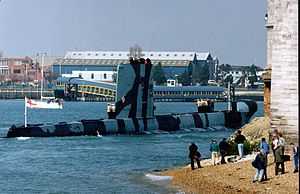HMS Opossum (S19)
 HMS Opossum returning to RN submarine base HMS Dolphin, Gosport, following combat operations in the Gulf War (1990–91) | |
| Career (UK) | |
|---|---|
| Name: | HMS Opossum |
| Builder: | Cammell Laird, Birkenhead |
| Laid down: | 21 December 1961 |
| Launched: | 23 May 1963 |
| Commissioned: | 5 June 1964 |
| Decommissioned: | August 1993 |
| Fate: | Paid off for disposal |
| General characteristics | |
| Class and type: | Oberon-class submarine |
| Displacement: | 2,030 long tons (2,063 t) surfaced 2,400 long tons (2,439 t) submerged |
| Length: | 295 ft 3 in (89.99 m) |
| Beam: | 26 ft 6 in (8.08 m) |
| Draught: | 18 ft (5.5 m) |
| Propulsion: | 2 diesels 3,680 bhp (2,744 kW) 2 electric motors of 6,000 shp 2 shafts |
| Speed: | 15 knots (28 km/h) surfaced 17 knots (31 km/h) submerged |
| Range: | 9,000 nautical miles (17,000 km) at 12 knots (22 km/h) |
| Complement: | 68 (6 officers, 62 petty officers and ratings) |
| Armament: | 8 × 21 in (530 mm) torpedo tubes (6 bow, 2 stern) |
HMS Opossum (S19) was an Oberon-class submarine in service with the Royal Navy from 1964 to 1993.
Design and construction
Opossum was the eleventh Oberon-class boat commissioned by the Royal Navy. She was built by Cammell Laird shipbuilder at Birkenhead and launched on 23 May 1963. She was commissioned on 5 June 1964.
Opossum was originally armed with Mk. 8 torpedoes and later with Mark 24 Tigerfish torpedoes. The class was also capable of firing the Harpoon anti-ship missile.
Operational history
In 1990, Opossum took part in the bicentennial celebrations at Pitcairn Island, marking the occasion with a two-day visit in September.[1]
Otus was deployed to the Persian Gulf during the 1991 Gulf War under Operation Granby.[2] On her return to Gosport, she was flying a Jolly Roger;[3] the only indication that the submarine had been involved in deploying and recovering Special Air Service and Special Boat Service personnel.[4][5]
On 14 July 1993, Opossum (which was travelling on the surface at the time) collided with the fishing vessel Amber Rose off the coast of Scotland.[6]
Fate
On paying off in 1993, the nameplate from HMS Opossum was given to St Edmundsbury council in commemoration of the submarine's association with the town of Bury St. Edmunds.[7]
The HMS Opossum Association is the veterans association for those who served on HMS Opossum. The association's members include submariners, and earlier veterans who served on the sloop/frigate HMS Opossum (U33).
References
- ↑ "Bicentenary Celebrations". Pitcairn Islands Philatelic Bureau. 2004. Retrieved 31 January 2015.
- ↑ "British Forces involved in Operation Granby". raf.mod.uk. 2015. Retrieved 31 January 2015.
- ↑ Hillbeck, Ian W. (2015). "Submarine Camouflage Schemes". Submariners Association, Barrow-in-Furness Branch. Retrieved 31 January 2015.
- ↑ Richards, Bill; Smith, Peter (December 2006). "Onslow's Jolly Roger". Signals (Australian National Maritime Museum) (77): 11. ISSN 1033-4688.
- ↑ Oliver, Sarah (2 April 2011). "Return of the Triumph: With the skull and crossbones flying defiantly at its mast, submarine that launched attack on Gaddafi comes home". Daily Mail Online. Retrieved 16 January 2014.
- ↑ Jeremy Hanley, Minister of State for the Armed Forces (18 January 1994). "Submarines (Fishing Vessels)". Parliamentary Debates (Hansard). United Kingdom: House of Commons. col. 506.
- ↑ Nicholas Soames, Minister of State for the Armed Forces (27 October 1994). "Appropriation Accounts". Parliamentary Debates (Hansard). United Kingdom: House of Commons. col. 739–740.
Publications
- Colledge, J. J.; Warlow, Ben (2006) [1969]. Ships of the Royal Navy: The Complete Record of all Fighting Ships of the Royal Navy (Rev. ed.). London: Chatham Publishing. ISBN 978-1-86176-281-8. OCLC 67375475.
External links
| ||||||||||||||||||||||||||